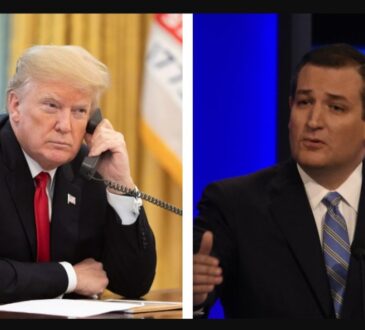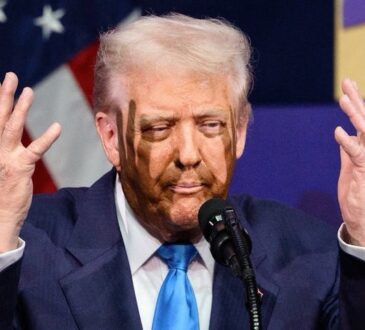
Donald Trump’s extravagant Halloween celebration at Mar-a-Lago felt like something straight out of The Great Gatsby, a dazzling display of wealth and luxury set against a backdrop of national hardship.
On Friday night, as millions of Americans worried about whether they would be able to afford food next week, the president was surrounded by glittering chandeliers, gold-trimmed decorations, and guests in flapper dresses and tuxedos.
The theme, “A Little Party Never Killed Nobody,” borrowed from a 1920s jazz-age song, but to many watching, it was a cruel irony — because while Trump and his wealthy friends partied in Palm Beach, America’s most vulnerable families were being pushed to the brink of hunger.
Reports from inside the Mar-a-Lago event described tables lined with champagne, gourmet dishes, and a live orchestra playing swing music as attendees laughed and danced late into the night. The ballroom itself, worth nearly $300 million and paid for in part by billionaire donors and cryptocurrency magnates, gleamed with gold light as Trump worked the room, shaking hands and smiling for cameras. To his supporters in the room, it was another grand night of celebration. But outside the resort’s walls, millions of ordinary Americans faced despair.
The timing of the party was impossible to ignore. Just hours earlier, two federal judges — one in Massachusetts and another in Rhode Island — had ruled that the Trump administration must use emergency funds to continue the Supplemental Nutrition Assistance Program (SNAP). Without the court’s intervention, the program was days away from running out of money because of the prolonged government shutdown. For over 40 million Americans, SNAP is a lifeline that helps them buy groceries. On average, it provides around $715 per month for a family of four, which amounts to roughly $6 a day per person — barely enough to survive.
Judge Indira Talwani said that halting the program was a serious misreading of the law and ordered the administration to tap into its contingency reserves immediately. Judge John McConnell echoed that sentiment, warning that the harm already caused to struggling families was “irreparable.” Despite these urgent rulings, the president seemed unfazed, choosing instead to indulge in a night of luxury with his donors.
Social media exploded with outrage as pictures and videos from Mar-a-Lago circulated online. The contrast between Trump’s glamorous party and the hunger crisis sweeping the nation became a symbol of how out of touch many believe his administration has become. “The universe couldn’t have written a clearer metaphor,” one user wrote. “Trump dances under chandeliers while families worry about dinner.” Another person commented, “He throws a Gatsby-themed party as Americans go hungry. It’s like he’s mocking the entire country.”
Political commentators noted the eerie parallels between Trump’s lavish event and the excesses described in F. Scott Fitzgerald’s The Great Gatsby — a story about wealth, greed, and emotional emptiness in the face of real human suffering. Like Gatsby, Trump was surrounded by opulence, applause, and admiration from those seeking proximity to power. But beyond the gates of Mar-a-Lago, millions of citizens were anxiously watching food supplies dwindle and benefits dry up.
At the same time, the nation entered its second month of the government shutdown. Vital programs that provide childcare assistance, health subsidies, and housing support were already suffering from funding shortages. The Congressional Budget Office estimated that Trump’s proposed cuts to Medicaid and the Children’s Health Insurance Program could eventually strip 10.5 million Americans of healthcare coverage by 2034 if not reversed.
Meanwhile, the Center on Budget and Policy Priorities warned that even if the USDA used its $6 billion emergency fund, it would only be enough to support about 60% of SNAP recipients for a single month. After that, millions would once again face uncertainty. Advocacy groups and nonprofits across the country began issuing emergency appeals, trying to fill the gap by distributing food donations. Local food banks, already overwhelmed, reported record demand.
Yet while the crisis deepened, Trump’s focus remained on spectacle. Reporters covering the event noted that his speech at the party was filled with humor and boasts about the economy, despite the financial anxiety gripping the country. “Everything is going to be fine,” he told the crowd, according to one guest. “We’re making America great again.”
For many Americans watching from home, the images from Mar-a-Lago felt like a painful reminder of inequality. The sight of a president dressed in luxury while millions struggled for food seemed to capture the growing divide between the wealthy elite and ordinary citizens. Social media users called it “tone-deaf,” “heartless,” and “a national disgrace.”
One viral post summed up the public mood: “Trump celebrates like Gatsby while the poor beg for bread. This isn’t leadership; it’s cruelty dressed in gold.”
Even as courts ordered the administration to restore SNAP funding, the uncertainty remained. Experts warned that unless Congress reopened the government and approved long-term funding, hunger would continue to rise, especially among children and the elderly. Economists also cautioned that the crisis could have lasting effects on public health and education, as families forced to choose between food and rent struggle to stay afloat.
Still, at Mar-a-Lago, the music played on. The chandeliers sparkled. Glasses clinked. And for one night, at least, the suffering of millions of Americans seemed far away from the laughter echoing through Donald Trump’s ballroom — a scene that, for many, perfectly captured the growing moral distance between America’s leaders and its people.




